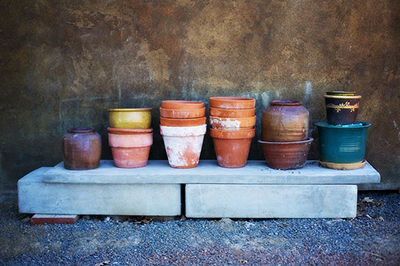So you’ve picked out your Wave® Petunias in all your favorite colors, or for your themed-color garden, and now you’re ready to choose your pots. Feeling overwhelmed? Don’t be! Patio gardens can definitely be a success with Wave Petunias. Here are some helpful tips to help you with that infamous question, “Now, what pot should I use?”

Photo: Jill Wellington from Pixabay
Pot size
You’ll want to choose a pot that’s more on the medium to larger size for best results with Wave plants. Don’t go too small since your plants need plenty of space to spread and grow. A flower pot that can hold three Wave plants is best — a 10 to 12-in. basket or container will do the job nicely. And stick to three plants per a pot that size since they need as much water and nutrients as possible to spread and showcase their beauty trailing over the sides of your planter. A pot too small will need many more drinks of water, sapping up too much of your precious time.
Pot material
Next, let’s talk about from what kind of material your container is made. Whether you choose a planter or basket, the material we’re referring to here concerns flower pots. There are several types of material you can choose from: plastic, ceramic, and terracotta are familiar choices. We’ll discuss the pros and cons of each here.
1) Plastic
Pros: They’re inexpensive, flexible and initially strong. Since plastic doesn’t have the wicking ability that clay has, this makes them an ideal container for gardeners who “sometimes” forget to water their plants.
Cons: Unfortunately, plastic deteriorates over time. This is especially true if your flower pots are exposed to cold temps or extreme amounts of UV. They will become brittle and crack, and eventually you will need to replace them before your terracotta pots.
2) Terracotta
Pros: Terracotta pots allow air and moisture movement through the sides of the pot, resulting in root stimulation and growth. These pots will wick moisture from the soil and make sure your plants don’t sit in wet conditions. This is great for gardeners that tend to overwater their plants. They also offer excellent drainage (Stay tuned, we’ll talk about this later in the next section).
Cons: Because these porous pots absorb moisture more quickly, you need to make sure your Wave Petunias don’t dry out. Also, unlike plastic and ceramic planters, you don’t get much of a variety since they come in just one style and one color.
3) Ceramic
Pros: Ceramics have a wonderful assortment of colors, patterns and styles that can make your patio garden unique to you.
Cons: Ceramic planters restrict air exchange. They might appear to be a pretty, glazed version of a terracotta pot, but not so fast. The coat of lacquer actually can prevent wicking moisture from the soil, which means your plant is susceptible to root rot. Plus, ceramic pots can be heavy once laden with soil and water, so moving them around your patio may be a struggle. (Hey! Gardening is exercise, right?)
Pot drainage
Whether you’re choosing a flower pot or planter made from plastic, terracotta or ceramic, be sure the pot has good drainage holes. If your pot sits on a tray or saucer to catch water, remember to lift the pot up off the tray to really drain well after any heavy rainfall. What does this mean for your Wave plants? Good drainage means less chance of root rot and ensures your Wave Petunias will thrive with the right amount of sun along with a good fertilizing and watering schedule.
So now you have the pros and cons of all types of pots for your Wave plants. Which is your go-to choice? Tell us about it in the comments below, or tag photos of your Wave pots on social with @WaveGardening to share your hits (or misses) with your fellow Wave Fans.